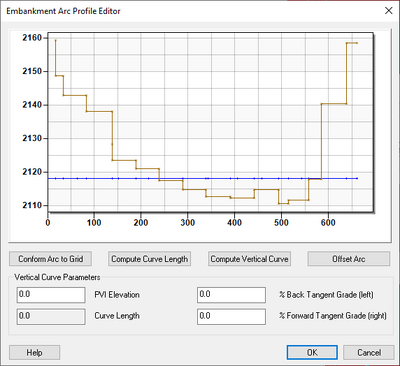WMS:GSSHA Embankment Arcs: Difference between revisions
No edit summary |
No edit summary |
||
| Line 32: | Line 32: | ||
}} | }} | ||
[[Category:GSSHA|E]] | |||
Revision as of 19:25, 17 February 2014
Embankment Arcs in WMS
In WMS, man-made embankments are represented as embankment arcs. These embankment arcs are placed along the centerline of the actual embankment. Often these embankment arcs represent roads that cross a drainage. The embankment arc can intersect a stream arc and an in-stream hydraulic structure (a culvert) placed at the intersection to allow water to pass through. For the embankment arc to function correctly in GSSHA, the elevations along the top of the arc must be defined. This is done through the Embankment Arc Profile Editor.
In the Embankment Arc Profile Editor the arc elevations can be generated by entering the parameters for a vertical curve. WMS will then take the given parameters and compute the correct elevation values for each vertex of the arc. The parameters needed for the vertical curve are the elevation of the point of vertical intercept, the left (back) tangent slope, the right (forward) tangent slope, and the curve length. Note that the arc need not be a straight line in plan view for the vertical curve to be computed.
The arc elevations can also be set by using the Conform Arc to Grid option, which sets the elevations of the arc to the corresponding grid elevations. The Offset Arc option will change all arc elevations by a constant specified by the user.
The Embankment Arc Profile Editor, shown in the image below, is accessible from the Feature Arc Attributes dialog in the GSSHA coverage. The feature arc type in order to access the dialog.
The Embankment Arc Profile Editor allows the embankment profile to be manually adjusted or set as a computed vertical curve.
Embankment Arcs in GSSHA
In WMS, the embankments are represented as feature arcs and are given profile elevations that define the top of the embankment. These feature arcs are then mapped to the nearest cell edge. The embankment acts as a wall all along the edge, interrupting flow between the two adjacent cells.
The wall elevation at each cell is determined by interpolation along the embankment arc. Once the water elevation has risen to this elevation, water will commence flowing over the embankment in a horizontal broad-crested weir fashion.
Related Topics
GSSHA | |
|---|---|
| XMS Wiki Links | Calibration (Automated • Manual • Output) • Channel Routing • Contaminants • Digital Dams • Embankment Arcs • Feature Objects (Arcs • Nodes • Polygons) • File Types • Groundwater • Groups • Hydraulic Structures • Job Control • Join SSURGO Data • Mapping Tables • Maps • Menu • Model Linkage • Multiple Simulations • Nutrients • Observations • Output Control • Overland Soil Erosion • Pipe and Node Parameters • Precipitation • Radar Rainfall • Save GSSHA Project File • Smooth GSSHA Streams • Snowmelt • Solution (Analysis • Data) |
| Related Tools | MWBM Wizard • Using Soil Type Data with GSSHA |
| GSSHA Wiki External Links | GSSHA Wiki: Overview • Primer • User's Manual • Tutorials |
